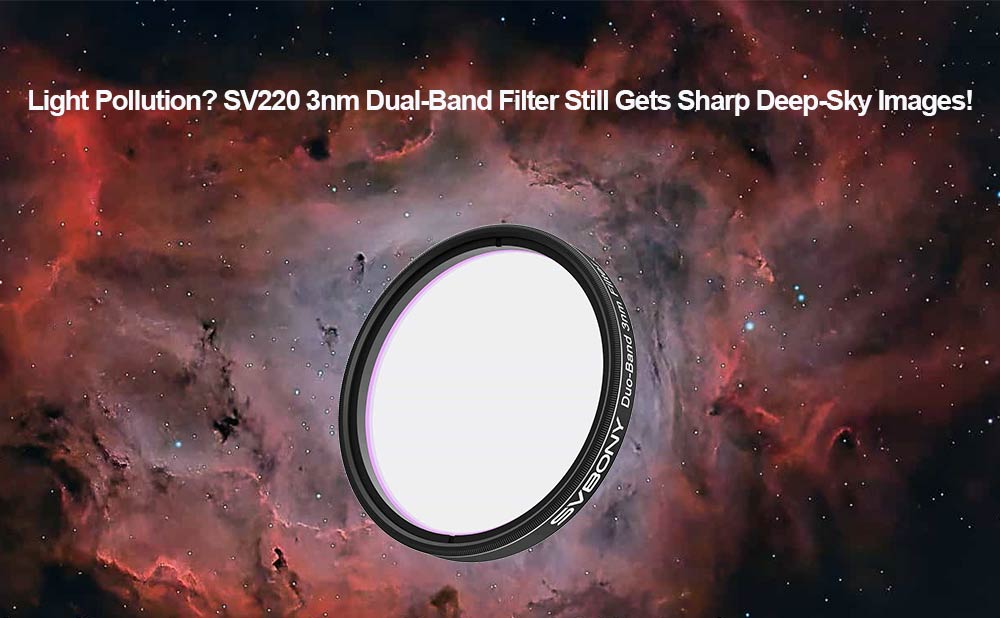Blog
Table of Contents

Light Pollution? SV220 3nm Dual-Band Filter Still Gets Sharp Deep-Sky Images!
Why the SV220 Is a "Light Pollution Beater"?
3nm Ultra-Narrow Bandwidth: Precision Targeting of Nebula Emission Lines
- Most emission nebulae (e.g., the Orion Nebula, Eagle Nebula) emit energy at specific wavelengths: H-alpha (hydrogen emission, 656.3nm, red) and O-III (oxygen ion emission, 500.7nm, cyan-blue) are the most vital for capturing their structure.
- The SV220 acts like a "precision sieve": it only allows light from these two bands to pass through while blocking over 99% of unwanted stray light - including sodium vapor streetlights (589nm), mercury lamps (435nm/546nm), and broad-spectrum moonlight.
- Compared to other narrowband filters (such as 7nm bandwidth), the 3nm design can greatly reduce light pollution interference, allowing you to capture clear and sharp nebula outlines even in urban areas.
Full-Frame Compatible: No Vignetting or Edge Blockage
The SV220 is full-frame compatible. It works seamlessly with full-frame telescopes/cameras, eliminating vignetting (darkening in the corners of the image) and edge occlusion.
Why it matters: Many filters, especially when used with larger sensors, can cause the edges of the image to appear darker (vignetting) or even block light from reaching the edges entirely. The SV220 ensures uniform light transmission across the entire sensor area.44mm clear aperture area, easily accommodating APS-C sensors (and working flawlessly with full-frame sensors too).
OD5 Light Blocking: Darkening the Night Sky Background
- OD5 means the filter blocks 99.999% of non-target wavelengths - effectively dimming the sky background by 100,000x.
- In practice, this transforms a washed-out, grayish night sky (from light pollution) into a deep, dark canvas. Nebula details - like the dark lanes of the Orion Nebula or the ring textures of M57 (Ring Nebula) - become sharply defined, with contrast boosted by at least 3x.
Even during a full moon, the SV220 lets you shoot normally. For enthusiasts short on time (who can’t wait for the new moon), it will be a great experience.
300-1050nm Wide Cut-Off Wavelength Range: Comprehensive Spectral Coverage
Real-World Use Cases: Who Needs the SV220?
Urban Astrophotographers: No More "Chasing Dark Skies"
Deep-Sky Beginners: Simplify Your Workflow (No More Filter Stacking)
Planetary Nebula & Supernova Remnant Shooters: A Detail "Amplifier"
Usage Tips: Get the Most Out of Your SV220
Focal Ratio Recommendation: Avoid ultra-fast telescopes (e.g., RASA series, f/5 or faster). High-speed optics can cause wavelength shifting, degrading image quality (some users report H-alpha cropping with RASA + SV220).
Exposure Settings: Due to the narrow bandwidth, keep ISO between 800 -1600 and single-shot exposure times between 15-60 seconds (adjust for light pollution levels). Longer exposures risk increased noise.
Cleaning & Maintenance: The filter has multi-layer anti-reflective coatings. Use a dedicated lens cloth to clean it - avoid alcohol or solvents, which can damage the coatings.
Final: Is the SV220 Worth Buying?
Bonus Offer: Purchase now and receive SVBONY exclusive stickers!


There are no customer reviews yet . Leave a Reply !